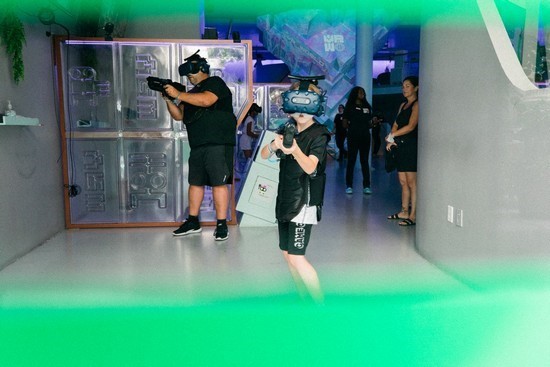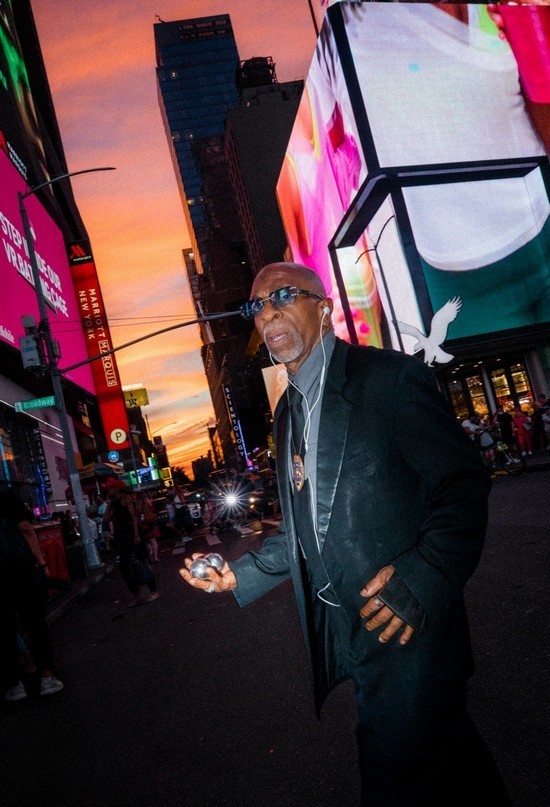Five sci-fi classics, one summer: How 1982 shaped our present
New York Times
last updated: Aug 09,2022

At the end of Christian Nyby’s 1951 sci-fi chiller “The
Thing from Another World” — about an Arctic expedition whose members are
stealthily decimated by an accidentally defrosted alien monster — a traumatized
journalist takes to the airwaves to deliver an urgent warning. “Watch the
skies,” he insists breathlessly, hinting at the possibility of a full-on
invasion in the final lines. “Keep looking. Keep watching the skies.”اضافة اعلان
This plea for eagle-eyed vigilance suited the postwar era of Pax Americana, in which economic prosperity was leveraged against a creeping paranoia — of threats coming from above or within. The final lines of the movie were prescient about the rise of the American science-fiction film, out of the B-movie trenches in the 1950s and into the firmament of the industry’s A-list several decades later.

The peak of this trajectory came in the summer of 1982, in which five authentic genre classics premiered within a one-month span. After its June 4, 1982, opening, “Star Trek II: The Wrath of Khan,” set an unexpected record by grossing about $14 million on its first weekend. Seven days later, Steven Spielberg’s “E.T.: The Extra-Terrestrial” debuted to $11 million but proved to have stubby, little box office legs, eventually grossing more than half a billion dollars worldwide. June 25 brought the competing releases of Ridley Scott’s ambitious tech-noir thriller “Blade Runner” and John Carpenter’s R-rated remake of “The Thing,” visions several shades darker than “E.T.”; both flopped as a prelude to their future cult devotion. On July 9, Disney’s technologically groundbreaking “Tron,” set in a virtual universe of video-game software, completed the quintet.
Not all of these movies were created equal artistically, but taken together, they made a compelling case for the increasing thematic flexibility of their genre.
Whether the summer of ’82 represented the gentrification of cinematic sci-fi or its artistic apex, the genre’s synthesis of spectacle and sociology had been underway for some time. Following the pulp fictions of the ’50s, if there was one movie that represented a great leap forward for cinematic science fiction, it was Stanley Kubrick’s epically scaled, narratively opaque 1968 film “2001: A Space Odyssey,” which not only featured a massive, mysterious monolith but also came to resemble one in the eyes of critics and audiences alike.

The film’s grandeur was undeniable, and so was its gravitas: It was an epic punctuated with a question mark. Almost a decade later, “Star Wars” used a similar array of special effects to cultivate more weightless sensations. In lieu of Kubrick’s anxious allegory about humans outsmarted and destroyed by their own technology, George Lucas put escapism on the table — “a long time ago, in a galaxy far, far away” — and staged a reassuringly Manichaean battle between good and evil, with very fine aliens on both sides.
The same year as “Star Wars,” Spielberg’s “Close Encounters of the Third Kind” rekindled the paranoid alien-invasion vibes of the ’50s with an optimistic twist. The film had originally been titled “Watch the Skies” in homage to Nyby’s classic, but it was an invitation to a more benevolent form of stargazing: Its climactic light show was as patriotic as Fourth of July fireworks, with a distinctly countercultural message worthy of Woodstock: Make love, not war (of the worlds).

What united “Star Wars” and “Close Encounters,” beyond their makers’ shared sense of genre history (and mechanics), were their direct appeals to both children and the inner children of grown-ups everywhere. In The New Yorker, the influential and acerbic critic Pauline Kael carped that George Lucas was “in the toy business.” Like the scientist at the end of “The Thing From Another World,” she was raising the alarm about what she saw as a powerful, pernicious influence: the infantilization of the mass audience by the special-effects spectacle.
Yet even Kael submitted to the shamelessly populist charms of “E.T.”. She wrote that the film, about the intimate friendship between a 10-year-old boy and a benign, petlike thing from another world, “reminds you of the goofiest dreams you had as a kid.”

With its opening images of flashlights cutting through darkened woods and the signature, fairy-tale tableaux of a 10-speed bicycle flying over the moon, “E.T.” is indeed dreamlike; released two years before Ronald Reagan’s campaign sold the promise of “Morning in America,” Spielberg conjured up the cinematic equivalent of a breaking dawn.
If the true legacy of “Star Wars” was the mutation of cinema into other potentially consumable products, the old-fashioned, flesh-and-blood heroics of “The Wrath of Khan” may have offered an appealing counterpoint. In a moment when the mainstream was either trying to court teenage or dumbing down, “Khan” proudly wore its 19th-century references on its Starfleet-issue sleeves.

After grousing that “gallivanting around the cosmos is a game for the young,” Capt. Kirk (William Shatner) is given a copy of Charles Dickens’ “A Tale of Two Cities” for his birthday. His rival, the genetically engineered, cryogenically frozen superman Khan (played by Ricardo Montalbán), fancies himself a newfangled Capt. Ahab, with the callow, complacent Kirk as his great white whale. “From hell’s heart, I stab at thee,” Khan hisses during a late confrontation.
In “Khan,” the presence of a high-tech invention called the Genesis Device, which brings life to barren worlds (and potentially resurrects dead Vulcans), was a shameless deus ex machina that doubled as an unheralded breakthrough. The brief interlude in which we see the device deployed was the first completely computer-generated sequence in a feature film — an example of special effects technicians (specifically, the magicians at Lucas’ visual effects company, Industrial Light and Magic) boldly going where no crew had gone before.

Following hot on Khan’s heels, “Tron” explored CGI’s potential more fulsomely. Originally conceived by director Steven Lisberger as an animated feature after playing a game of Pong, the film essentially reconfigured Lewis Carroll for the digital age, with a programmer in place of Alice and a mainframe in place of a looking glass. Suspecting that his work has been plagiarized, a game developer confronts his nefarious boss only to be uploaded into his own arcade-style creation as punishment. This narrative worked effectively — if accidentally — as an allegory for the increasingly technocratic nature of studio filmmaking in the aftermath of the New Hollywood. What could be more symbolic of a paradigm shift than having Jeff Bridges, who had starred in Michael Cimino’s disastrous, industry-changing 1980 Western “Heaven’s Gate,” beamed against his will into 3D gladiatorial combat by a sentient artificial intelligence with echoes of the malevolent HAL 9000 from “2001?”
In The New York Times, Janet Maslin opined that by following the example of “Star Wars,” the new film succeeded in being “loud, bright, and empty.” The subtext to “Tron’s” cool reception was that if Lisberger’s vision represented the state of the art, the art itself was in trouble.

Where “Tron” imagined the plight of a human suddenly reduced to a ghost in the machine, “Blade Runner” featured robots who yearned more than anything to be flesh and blood. Freely adapted from a short story by sci-fi great Philip K. Dick, whose neurotic narratives examined the dangerous intersection of technology and psychology, “Blade Runner” recruited Harrison Ford, the charismatic MVP from “Star Wars”, for box office muscle.
The new film’s greatest creation, though, was Rutger Hauer’s atavistic replicant Roy Batty, a dissident being hunted by Ford’s titular character, Rick Deckard. In a film about androids raging against their puppet master, this grungy, muscular Pinocchio steals the show. The fight in which Roy brutally subdues Deckard on a rooftop shocked audiences not used to seeing Han Solo (or Indiana Jones) bested in hand-to-hand combat. The scene’s unexpected payoff comes via a soulful soliloquy by Roy that stops the movie in its tracks and momentarily imbues it with some of the same pulpy poetry as “The Wrath of Khan.”
Brilliantly designed and meticulously detailed by Ridley Scott, “Blade Runner” was a visual triumph. When Roy insists, “I’ve seen things you people wouldn’t believe,” he could be describing his own movie.
The grudging tone of the initial reception to “Blade Runner” was nothing compared with the contempt for “The Thing,” which also chronicled the desire of an ornery life form to become human: imitation by way of contagion. In remounting “The Thing From Another World” Carpenter kept the snowy backdrop and then-there-were-none plotting. The film follows the same basic beats as the original, with a group of explorers discovering a downed flying saucer in a remote location and being killed off one by one by its elusive passenger.

The key line in “The Thing,” uttered in the aftermath of a particularly gruesome metamorphosis, was a profane version of “you’ve got to be kidding me”, an acknowledgment joining shock and awe with picaresque slapstick. The problem was that audiences forgot to laugh.
Carpenter’s brilliantly executed exercise in nervous tension was widely dismissed as sadistic grotesquerie; the idea that it might have been satirizing Reaganite fears of ideological conformity (or new waves of insidious, scarily transmissible diseases) was barely considered. As penance, Carpenter’s next movie was the good-natured “Starman,” which was basically “E.T.” for grown-ups, starring a serene Jeff Bridges as the dude who fell to Earth.
It’s telling that the reputations of “Blade Runner” and “The Thing” have been rehabilitated to the point of classic status, in addition to enduring as valuable, renovatable intellectual property.
Both “Blade Runner 2049” and “The Thing” remake (2011) feature scenes in which 21st-century CGI is used to painstakingly recreate the analog wonders of 1982. So does “Tron: Legacy” (2010), which not only brought back Bridges but also stranded him on the other side of the uncanny valley via a not-quite-convincing digital doppelgänger modeled on his younger self. One way to look at the imagery in these films is as the artistic equivalent of Khan’s Genesis Device, sentimentally resurrecting the cinematic past for viewers.
But there’s also something necrophiliac about the nostalgia. In the most shocking moment of “Blade Runner 2049,” the voluptuous replicant played in the original by Sean Young appears, looking much more convincing than Bridges in “Tron: Legacy,” only to be unceremoniously shot in the head.
The only standout of 1982’s Summer of Sci-Fi that has not been remade, reimagined, or sequelized is “E.T.,” and it probably never will be; if it’s possible for a film to be both a time capsule and timeless, it fits the bill.
This vow of chastity did not keep Spielberg from strategically re-creating — and defacing — his late friend Kubrick’s “The Shining” in “Ready Player One” (2018), a spiritual update of “Tron” set in a world where the most ubiquitous online role-playing games offer total immersion in 1980s multiplex nostalgia.
“Ready Player One” was coolly received, but its combination of exploitation and critique of retro aesthetics (and reactionary fandom) was nevertheless on target. In a moment when “Stranger Things” has recalibrated our pop-cultural compass back to the days of “Morning in America” — featuring not only Kate Bush and Journey but also kids bicycling furiously through back streets — it’s worth contemplating why they do not (or cannot) make them like they used to. This month, “E.T.” will receive a rerelease in Imax theaters. It’s a throwback that feels right on time, a reminder of when blockbusters felt like events rather than obligations, and nothing could be more exhilarating than watching the skies.
Read more Entertainment
Jordan News
This plea for eagle-eyed vigilance suited the postwar era of Pax Americana, in which economic prosperity was leveraged against a creeping paranoia — of threats coming from above or within. The final lines of the movie were prescient about the rise of the American science-fiction film, out of the B-movie trenches in the 1950s and into the firmament of the industry’s A-list several decades later.

The peak of this trajectory came in the summer of 1982, in which five authentic genre classics premiered within a one-month span. After its June 4, 1982, opening, “Star Trek II: The Wrath of Khan,” set an unexpected record by grossing about $14 million on its first weekend. Seven days later, Steven Spielberg’s “E.T.: The Extra-Terrestrial” debuted to $11 million but proved to have stubby, little box office legs, eventually grossing more than half a billion dollars worldwide. June 25 brought the competing releases of Ridley Scott’s ambitious tech-noir thriller “Blade Runner” and John Carpenter’s R-rated remake of “The Thing,” visions several shades darker than “E.T.”; both flopped as a prelude to their future cult devotion. On July 9, Disney’s technologically groundbreaking “Tron,” set in a virtual universe of video-game software, completed the quintet.
Not all of these movies were created equal artistically, but taken together, they made a compelling case for the increasing thematic flexibility of their genre.
Whether the summer of ’82 represented the gentrification of cinematic sci-fi or its artistic apex, the genre’s synthesis of spectacle and sociology had been underway for some time. Following the pulp fictions of the ’50s, if there was one movie that represented a great leap forward for cinematic science fiction, it was Stanley Kubrick’s epically scaled, narratively opaque 1968 film “2001: A Space Odyssey,” which not only featured a massive, mysterious monolith but also came to resemble one in the eyes of critics and audiences alike.

The film’s grandeur was undeniable, and so was its gravitas: It was an epic punctuated with a question mark. Almost a decade later, “Star Wars” used a similar array of special effects to cultivate more weightless sensations. In lieu of Kubrick’s anxious allegory about humans outsmarted and destroyed by their own technology, George Lucas put escapism on the table — “a long time ago, in a galaxy far, far away” — and staged a reassuringly Manichaean battle between good and evil, with very fine aliens on both sides.
The same year as “Star Wars,” Spielberg’s “Close Encounters of the Third Kind” rekindled the paranoid alien-invasion vibes of the ’50s with an optimistic twist. The film had originally been titled “Watch the Skies” in homage to Nyby’s classic, but it was an invitation to a more benevolent form of stargazing: Its climactic light show was as patriotic as Fourth of July fireworks, with a distinctly countercultural message worthy of Woodstock: Make love, not war (of the worlds).

What united “Star Wars” and “Close Encounters,” beyond their makers’ shared sense of genre history (and mechanics), were their direct appeals to both children and the inner children of grown-ups everywhere. In The New Yorker, the influential and acerbic critic Pauline Kael carped that George Lucas was “in the toy business.” Like the scientist at the end of “The Thing From Another World,” she was raising the alarm about what she saw as a powerful, pernicious influence: the infantilization of the mass audience by the special-effects spectacle.
Yet even Kael submitted to the shamelessly populist charms of “E.T.”. She wrote that the film, about the intimate friendship between a 10-year-old boy and a benign, petlike thing from another world, “reminds you of the goofiest dreams you had as a kid.”

With its opening images of flashlights cutting through darkened woods and the signature, fairy-tale tableaux of a 10-speed bicycle flying over the moon, “E.T.” is indeed dreamlike; released two years before Ronald Reagan’s campaign sold the promise of “Morning in America,” Spielberg conjured up the cinematic equivalent of a breaking dawn.
If the true legacy of “Star Wars” was the mutation of cinema into other potentially consumable products, the old-fashioned, flesh-and-blood heroics of “The Wrath of Khan” may have offered an appealing counterpoint. In a moment when the mainstream was either trying to court teenage or dumbing down, “Khan” proudly wore its 19th-century references on its Starfleet-issue sleeves.

After grousing that “gallivanting around the cosmos is a game for the young,” Capt. Kirk (William Shatner) is given a copy of Charles Dickens’ “A Tale of Two Cities” for his birthday. His rival, the genetically engineered, cryogenically frozen superman Khan (played by Ricardo Montalbán), fancies himself a newfangled Capt. Ahab, with the callow, complacent Kirk as his great white whale. “From hell’s heart, I stab at thee,” Khan hisses during a late confrontation.
In “Khan,” the presence of a high-tech invention called the Genesis Device, which brings life to barren worlds (and potentially resurrects dead Vulcans), was a shameless deus ex machina that doubled as an unheralded breakthrough. The brief interlude in which we see the device deployed was the first completely computer-generated sequence in a feature film — an example of special effects technicians (specifically, the magicians at Lucas’ visual effects company, Industrial Light and Magic) boldly going where no crew had gone before.

Following hot on Khan’s heels, “Tron” explored CGI’s potential more fulsomely. Originally conceived by director Steven Lisberger as an animated feature after playing a game of Pong, the film essentially reconfigured Lewis Carroll for the digital age, with a programmer in place of Alice and a mainframe in place of a looking glass. Suspecting that his work has been plagiarized, a game developer confronts his nefarious boss only to be uploaded into his own arcade-style creation as punishment. This narrative worked effectively — if accidentally — as an allegory for the increasingly technocratic nature of studio filmmaking in the aftermath of the New Hollywood. What could be more symbolic of a paradigm shift than having Jeff Bridges, who had starred in Michael Cimino’s disastrous, industry-changing 1980 Western “Heaven’s Gate,” beamed against his will into 3D gladiatorial combat by a sentient artificial intelligence with echoes of the malevolent HAL 9000 from “2001?”
In The New York Times, Janet Maslin opined that by following the example of “Star Wars,” the new film succeeded in being “loud, bright, and empty.” The subtext to “Tron’s” cool reception was that if Lisberger’s vision represented the state of the art, the art itself was in trouble.

Where “Tron” imagined the plight of a human suddenly reduced to a ghost in the machine, “Blade Runner” featured robots who yearned more than anything to be flesh and blood. Freely adapted from a short story by sci-fi great Philip K. Dick, whose neurotic narratives examined the dangerous intersection of technology and psychology, “Blade Runner” recruited Harrison Ford, the charismatic MVP from “Star Wars”, for box office muscle.
The new film’s greatest creation, though, was Rutger Hauer’s atavistic replicant Roy Batty, a dissident being hunted by Ford’s titular character, Rick Deckard. In a film about androids raging against their puppet master, this grungy, muscular Pinocchio steals the show. The fight in which Roy brutally subdues Deckard on a rooftop shocked audiences not used to seeing Han Solo (or Indiana Jones) bested in hand-to-hand combat. The scene’s unexpected payoff comes via a soulful soliloquy by Roy that stops the movie in its tracks and momentarily imbues it with some of the same pulpy poetry as “The Wrath of Khan.”
Brilliantly designed and meticulously detailed by Ridley Scott, “Blade Runner” was a visual triumph. When Roy insists, “I’ve seen things you people wouldn’t believe,” he could be describing his own movie.
The grudging tone of the initial reception to “Blade Runner” was nothing compared with the contempt for “The Thing,” which also chronicled the desire of an ornery life form to become human: imitation by way of contagion. In remounting “The Thing From Another World” Carpenter kept the snowy backdrop and then-there-were-none plotting. The film follows the same basic beats as the original, with a group of explorers discovering a downed flying saucer in a remote location and being killed off one by one by its elusive passenger.

The key line in “The Thing,” uttered in the aftermath of a particularly gruesome metamorphosis, was a profane version of “you’ve got to be kidding me”, an acknowledgment joining shock and awe with picaresque slapstick. The problem was that audiences forgot to laugh.
Carpenter’s brilliantly executed exercise in nervous tension was widely dismissed as sadistic grotesquerie; the idea that it might have been satirizing Reaganite fears of ideological conformity (or new waves of insidious, scarily transmissible diseases) was barely considered. As penance, Carpenter’s next movie was the good-natured “Starman,” which was basically “E.T.” for grown-ups, starring a serene Jeff Bridges as the dude who fell to Earth.
It’s telling that the reputations of “Blade Runner” and “The Thing” have been rehabilitated to the point of classic status, in addition to enduring as valuable, renovatable intellectual property.
Both “Blade Runner 2049” and “The Thing” remake (2011) feature scenes in which 21st-century CGI is used to painstakingly recreate the analog wonders of 1982. So does “Tron: Legacy” (2010), which not only brought back Bridges but also stranded him on the other side of the uncanny valley via a not-quite-convincing digital doppelgänger modeled on his younger self. One way to look at the imagery in these films is as the artistic equivalent of Khan’s Genesis Device, sentimentally resurrecting the cinematic past for viewers.
But there’s also something necrophiliac about the nostalgia. In the most shocking moment of “Blade Runner 2049,” the voluptuous replicant played in the original by Sean Young appears, looking much more convincing than Bridges in “Tron: Legacy,” only to be unceremoniously shot in the head.
The only standout of 1982’s Summer of Sci-Fi that has not been remade, reimagined, or sequelized is “E.T.,” and it probably never will be; if it’s possible for a film to be both a time capsule and timeless, it fits the bill.
This vow of chastity did not keep Spielberg from strategically re-creating — and defacing — his late friend Kubrick’s “The Shining” in “Ready Player One” (2018), a spiritual update of “Tron” set in a world where the most ubiquitous online role-playing games offer total immersion in 1980s multiplex nostalgia.
“Ready Player One” was coolly received, but its combination of exploitation and critique of retro aesthetics (and reactionary fandom) was nevertheless on target. In a moment when “Stranger Things” has recalibrated our pop-cultural compass back to the days of “Morning in America” — featuring not only Kate Bush and Journey but also kids bicycling furiously through back streets — it’s worth contemplating why they do not (or cannot) make them like they used to. This month, “E.T.” will receive a rerelease in Imax theaters. It’s a throwback that feels right on time, a reminder of when blockbusters felt like events rather than obligations, and nothing could be more exhilarating than watching the skies.
Read more Entertainment
Jordan News


